Village Nature School
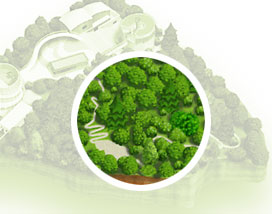
| Produced by | |
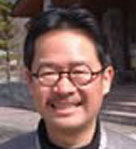 |  |
| Tadashi Kawashima | Maako Kido |
Through programs in which participants come in contact with soil and immerse themselves in the satoyama landscape, the Village Nature School will offer opportunities to learn about the superior mechanism of coexistence with nature that the satoyama embodies and the wisdom and techniques of our predecessors, and to have an enjoyable time coming to an awareness of the relationship between people and satoyama.
Overview of facilities (all names are tentative)
Old Kiln Cottage: Techniques with soil!
Exhibits and commentary on the history of satoyama and kilns. Workshops in which participants acquaint themselves with soil (e.g., touching and kneading soil to make clay balls).
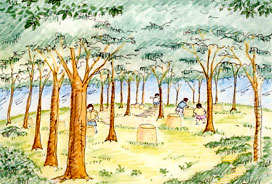
Hill of Spirits: Legends of soil!
View of and commentary on the satoyama area (Kaisho Forest and mountains of the Owari district). Resting place at the hilltop. Site for rituals of the mountain shrine (offerings, services). Projection of a sacred atmosphere using art objects in the image of forest spirits.
Hill of Mountain Cherries: Return to soil!
Participants will step inside domes made of soil and experience oneness with soil, or lie down on the soil and look up at the mountain cherry trees from the surface of the earth.
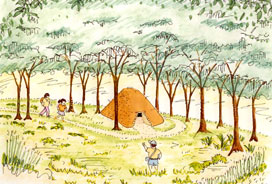
Program Image of Village Nature School
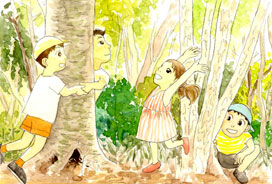 Participants will go out on entertaining interactive programs in the satoyama with interpreters.
Participants will go out on entertaining interactive programs in the satoyama with interpreters.
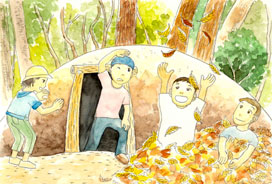 Virtual experience program
Virtual experience program
Through the virtual experience of becoming soil or components of nature, such as by stepping inside soil domes or being buried in leaves, participants will be encouraged to gain new perspectives.
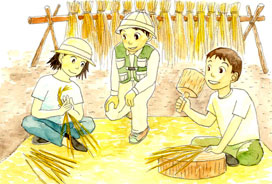 Seasonal programs
Seasonal programs
In satoyama, there are tasks, events and customs for each of the four seasons. Interactive programs suited to the season will be offered.
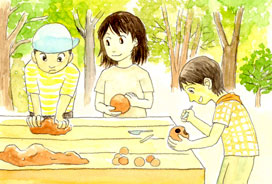 Touching and feeling soil
Touching and feeling soil
The area around the site has historically had a thriving ceramics industry, and its people have had close ties with the soil. Participants will knead soil and have a try at making objects with soil.
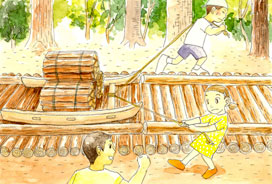 Examples of satoyama culture experiences
Examples of satoyama culture experiences
Participants will learn about the wisdom, techniques and customs of our predecessors handed down in satoyama through interactive programs, e.g., carrying loads on kinma sleds.
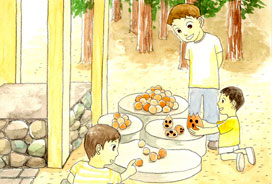 Gratitude to nature
Gratitude to nature
Interactive programs will be held that reenact old customs in which people expressed gratitude to the deities and spirits of the forest and prayed to them for fertility by making offerings in rituals and festivals.
Interpreter-guided programs
All programs at the Village Nature School will be guided by interpreters. The purpose of the programs will be to encourage participants to sense the messages given off by the satoyama of the site--not just the nature itself, but also its historical and cultural backgrounds--and to convey to them the theme of the program, as well as the theme of the Village Nature School, through a number of activities offered by interpreters. Rather then giving detailed explanations the focus will be on direct experience, and the programs will consist of activities that allow participants to feel with their own sensitivities the satoyama landscape of the site and to enjoy themselves as they come to an awareness of the relationship between people and nature.
Soil Trail Course
Through interactive programs, participants will gain a sense of the relationship between soil and people, and consider the idea of being born from the soil and eventually returning to the soil, and the extraordinary relationship between soil and life. Also, the programs will encourage in participants an awareness of the relationship between day-to-day life and soil.
*Techniques with soil ![]() soil as raw material, creative activity using soil, use of soil for energy
soil as raw material, creative activity using soil, use of soil for energy
*Legends of soil ![]() construction, rituals, harmony between humanity and nature
construction, rituals, harmony between humanity and nature
*Return to soil ![]() forest soil, material cycle
forest soil, material cycle
Village Trail Course
With the satoyama landscape of the Seto Area as the setting, participants will get a feel for lifestyles adapted to each of the seasons and the culture of the Japanese as an accumulation of knowledge cultivated through their relationship with nature from the standpoints of agriculture and folklore design.
*re-creation of scenes of satoyama life
*Re-creation of local traditional culture through exhibits
*Comparisons between the lifestyles and cultures of Japan and the world
*In consideration of the impact on the environment, the number of daily visitors is scheduled to be limited.


